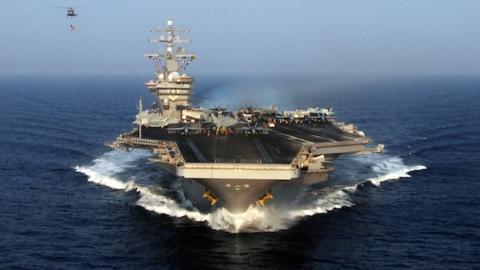Reports about Russian presence at Syria’s Latakia airbase include road construction, tarmac additions, and a new control tower, but little ink is wasted on Latakia’s proximity to Russia’s Tartus naval base 50 miles north. Together, these facilities allow guided missile cruisers, amphibious ships, destroyers, anti-submarine warfare, and reconnaissance ships to operate in the Eastern Mediterranean without having to return to home bases in the Black Sea. Access to a newly enlarged airbase allows the Russian military to replace naval crews by air, makes parts and ammunition more accessible, and affords better intelligence via patrol aircraft.
Massive immigration flows; the Syrian civil war; the possibility of ISIS victory in Syria or Libya—or both; Turkey’s embrace of Islamism; the likelihood that the U.S. administration’s deal with Iran will result in nuclear proliferation; and continued instability in Egypt all show that from the Aegean to North Africa the Mediterranean is reverting to its historic instability.
But the U.S. has failed to plan for replenishment of America’s depleted Sixth Fleet. This absence of sufficient seapower sets the stage for trouble reaching far beyond the region, raising the larger question of how the U.S. is planning future naval forces.
Aircraft carriers are an instructive example. In the 2007 Defense Authorization bill, Congress wrote into law that we must not go below eleven. Since December 2012, this has been lowered to ten so that USS Enterprise could be retired before USS Ford’s 2016 commissioning. The law was passed alongside development of the 2007 Maritime Strategy, which codified the need for combat power in two regions, the Arabian Gulf/Indian Ocean and Western Pacific. The strategy made certain key assumptions to arrive at eleven carriers operating out of two combat hubs.
First, the hubs would be occupied by a carrier continuously and indefinitely. This means no gaps in coverage, with coverage provided far into the future. Second, it does not matter specifically where the hubs are. Carriers could move to conduct operations outside of one of the hubs. The final assumption is that only one carrier at a time is required to “fill” a hub. With these assumptions, the math works like this:
To provide carriers in two regions, two must be in place. One will have recently arrived home. One will be on the way, with another in training. Thus, eight are necessary. However, eight carriers can provide continuous, but not indefinite coverage. Carriers require maintenance, like a three-and-a-half year midlife refueling process. Extended maintenance levies a requirement for a ninth carrier.
But ships need regular maintenance, too. Maintenance periods occur between regular deployments, lasting three to six months. So two additional carriers are required, one in maintenance for each hub, bringing us to eleven total.
The fleet has been at ten carriers since December 2012. This fall, Navy officials announced a gap of several months in the Arabian Gulf/Indian Ocean hub. After four years of lengthening deployments and preserving coverage from operationally strained geographic distances, ten proved insufficient to cover two hubs.
Keep in mind, eleven carriers are required for two hubs each requiring one carrier. If U.S. leadership determines a third carrier is required to supplement an existing hub (as was the case in the Middle East from 2010-2013) or to establish a temporary hub elsewhere, eleven carriers instantly become insufficient.
A new 2015 Navy strategy does not repeat the “two hub” construct, though combat power continues to be called for in the Western Pacific and the Middle East. Additionally, there has been no discussion of reducing naval presence in these two hubs.
The two hub concept was an artifact of the “War on Terror” and the Navy’s desire for a compelling planning narrative. China’s concerning behavior had yet to emerge, and Russia’s invasion of Georgia was a year away. Eleven carriers were deemed sufficient to meet the requirements of a world without today’s “near peer” power competition. This won’t be sufficient to preserve American naval superiority beyond 2015.
The Navy requires a third hub in the Mediterranean, where forces were routinely deployed from shortly after WWII to the mid-1990’s, and where today’s immigration crisis is a sign of instability. An eleven carrier fleet only barely meets the requirements for a two hub Navy. Adding a third hub requires sixteen carriers for continuous and indefinite coverage. Building such a force would take time and money, as more escorts and logistics ships would also be needed.
Nor is a robust Mediterranean fleet is not the sole justification. Were two carriers required to answer a crisis today (Bill Clinton dispatched two aircraft carrier battle groups during the 1996 Taiwan crisis) the U.S. would be hard pressed to respond.
The Navy will not develop an adequate carrier fleet with concomitant growth of support ships, aircraft, and people without strong leadership. American military power is in a state of decline. Larger, more powerful naval forces would assist immeasurably in reversing this.
The Hudson Center for American Seapower will release the report from which this piece is adapted, “Sharpening the Spear: the Aircraft Carrier, the Joint Force, and High-End Conflict,” on October 8.




















